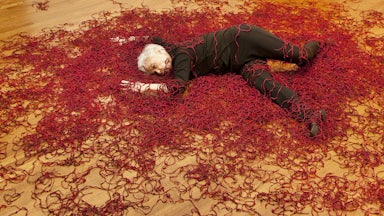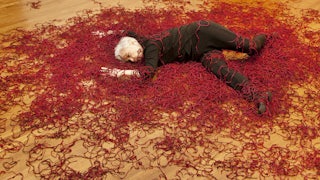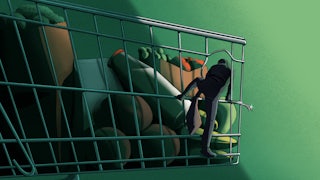Simple Passion, Annie Ernaux’s very short, unaccountably gripping 1991 book about her total absorption in an affair with a married Russian diplomat, begins by analyzing the “shattering” experience of seeing a pornographic film on TV for the first time. Writing, she thinks, ought to aim for a similar effect on the reader: “a feeling of anxiety and stupefaction, a suspension of moral judgment.” Ernaux is capable of a precision that doesn’t create distance (clinical, judgmental, ironic): She pins a butterfly but keeps it alive and fluttering while you look. This she can do even with impressions that might seem too brief or trivial or familiar or purely sensory to be captured, like the shock of encountering in casual close-up, “among the shimmerings of the screen,” a penis, a vagina, sperm—a combination that for centuries, as Ernaux puts it, “one could barely take in without dying.”
That phrase, with its historical sweep, contains another sliver of autobiography. Toward the end of Simple Passion, Ernaux describes returning, on a heartbroken whim after her lover’s abrupt departure, to the scene of a traumatic abortion she’d had as a student many years before in 1963, in the seventeenth arrondissement in Paris. Walking once more along the Passage Cardinet, she pictures the old woman who had performed the illegal procedure and then “insisted on accompanying me to the nearest station, no doubt to make sure that I wouldn’t collapse on her doorstep with a tube up my belly.” Ernaux asks herself “what the difference was between this past reality and literature, perhaps just a feeling of disbelief that I had actually been there one day, something I wouldn’t have felt in the case of a fictional character.”
The sense of dividedness from prior selves that nonetheless remain vividly accessible is part of the moment-by-moment drama of reading Ernaux. And the related tension between knowing that an experience is commonplace and being wretchedly alone in it is likewise one she sustains brilliantly in Happening, her 2000 book about that unwanted pregnancy that nearly derailed her life. Ernaux gives the process of writing a book as much visceral urgency and substance as anything else she describes—any fundamental separation of the writer from people just getting through the day is erased in her work, because she’s able to connect her artistic desires and struggles to the mind-body problems we all have.
An alienated claustrophobia—you can’t believe it could really be happening to you and you can’t make it stop—pervades Audrey Diwan’s film adaptation of Happening, which won the Golden Lion at Venice last year. Diwan resists the temptation to use Ernaux’s first-person narration in voice-over, relying instead on the vividness of the physical and social observations she recorded: Anne (Anamaria Vartolomei), a student in the northern port city of Rouen, standing over a dorm toilet and trying to screw up the courage to hack through her umbilical cord with scissors; the fear and loathing she inspires in the doctors she approaches for help, and the tricks they employ to keep her pregnant; Jean (Kacey Mottet Klein), the fellow student she hopes will introduce her to other women who have had the procedure—he first tries to sleep with her, since there’s “no risk” for the time being. Still, the film forgoes some pungent period detail: Its Jean, for instance, is single, whereas the real-life version makes his “pragmatic” move on Ernaux while his wife, having served rabbit stew for dinner, is out on an errand and their toddler wails in the next room.
Diwan’s most striking decision comes in the anxious, sinister angles and movements of her camera. We hover behind or beside Anne, often watching the action from just over her shoulder, like a surveillance camera zoomed all the way in. Sometimes this makes it feel as if Anne’s crimes, her shameful attempts at a forbidden autonomy, are catching up with her: No one else has quite figured out that she is swiping food from the communal refrigerator, vomiting in the toilets, concealing her altered figure in the showers—but we, the audience, see it all. At other times, it’s as though we ourselves are the villain of the piece, creeping inexorably up on her. But most often I had the eerie, impossible feeling that the perspective I was being offered was Anne’s: my own body perceived at an uncomfortably close angle yet in sharp focus, entrapping me, while other people’s lives outside went fuzzily on; seeing what I saw without fully inhabiting myself, so that I couldn’t influence the course of events at all.
An abortion film, with its too-fast-yet-too-slow narrative time, is inevitably as tense and nauseating as a certain kind of thriller, and it has an existentialist bite: The protagonist is menaced from within and without (“He’s gotten strong,” the abortionist tells Anne, in the cool appraising tone of a respectful adversary); the situation worsens steadily, with or without action. The small, cumulative horrors of Anne’s experience, the mundane, extended suspense, and her continually frustrated efforts to cut through the misogynistic netting around her, so ubiquitous that almost no one else seems aware of it or able to imagine its absence, made me think of The Assistant, Kitty Green’s quiet, insistently creepy portrait of a workplace dominated by a Harvey Weinstein figure. Happening feels contemporary in its style and its subtle flattening of historical time, even as it attempts to portray a set of circumstances specific to the 1960s. (Not all the circumstances, alas: Two U.S. state governors signed abortion bans into law the week I filed this piece.)
The film marks the weeks of Anne’s pregnancy in title cards. She and her friends spend early scenes adjusting each other’s bra straps and hemlines to look sexier for a night out dancing, sharing the last piece of chewing gum, or chanting their conjugations in unison on the sun-bleached grass, until her unfortunate loss of the social game they’re all forced to play begins to isolate her. The friends pull away; the teacher who sees Anne as promising enough to teach herself is offended by her sudden, unexplained inattention. There are an enormous number of classroom scenes, seemingly to underline what missing or flunking the exams would mean for Anne, whose former factory-worker parents run a small-town bar-cum-store.
The young man who impregnated Anne feels no obligation to help, though he is still keen to take her on vacation with his friends, the children of doctors and lawyers, so long as she makes herself agreeable. “Same old insolence,” he says when she doesn’t comply. “Think that’s how to solve life’s problems?” She retorts: “I solve them as best I can.” The portrayal of class, though, feels both less rich and less stark here than in Ernaux’s book. “If I don’t pass these exams, I’ll be on a tractor next year,” one of the girls says. Anne’s mother slips her cash for books and later slaps her for asking: “What do you know about exams?” But we don’t see anything like the moment in the book following Ernaux’s hospitalization for loss of blood after she finally gets an effective abortion: A nurse reprimands her for failing to let the doctor know that she was “like him”—a university student, a person worthy of respect, rather than the loose little nothing he’d assumed. The doctor, having yelled an obscenity at her in the operating room, is outraged at being so misled.
The film’s dialogue can feel schematic, a reminder of how little direct speech Ernaux reports in her books—her distillation of experience renders it unnecessary, and the sentences we do get are those so strange and angular or so temporally specific as to have lodged in memory. What the writers of Happening (Marcia Romano and Diwan) make up to fill the gaps is sometimes jarringly unnatural, signposting the era. “When Camus looks at us, his gaze pierces through us. He inspires justice, humanity in us. Sartre is more ambiguous,” one of the girls remarks over lunch at the cafeteria. “Sartre is hard to figure and he backs the Communists, he backs Stalin, denies the mass murder.” “My dad’s a Communist and he never killed a soul,” another responds.
Adapting Ernaux would seem to be a trial, because so much of what’s distinctive in her work comes not from her material but from witnessing how she records and transforms it. That may be true for any writer, but the gulf between the two is especially wide with Ernaux, such that some of her most thrilling feats come where the subject matter seems least promising—the premise of a book so thin that she can’t possibly pull it off—as in Simple Passion or The Possession, her account of an extended bout of sexual jealousy after the younger man she’s dumped takes up with someone else. (If you want to be ravished, try reading Simple Passion right after you’ve sat through Danielle Arbid’s stubbornly tedious recent adaptation.)
Happening is most effective in its wordless sequences, when the audience can stay absorbed in the intense physicality of Anne’s predicament, the all-consuming anxiety that drains her intellectual and emotional energies. But without the nimbleness that Ernaux’s eccentric narrative structures allow her, the film risks retreating into an overfamiliar shape. Near the end, Anne asks the teacher for help catching up on his course, and explains that her seeming lack of interest had been just a symptom of “the illness that strikes only women and turns them into housewives.” When he asks if she still intends to teach, she announces that that’s no longer “what matters most” to her—now she wants to write.
Of course, this is the natural, the most obvious trajectory for the protagonist—any reader of Happening will know that its author eventually became one of France’s most famous writers. But to use this as an on-screen resolution feels a little cheap, threatening to squeeze Ernaux’s ordeal into that hoary vessel, the hero’s journey in which a gifted, spirited young person comes through a formative trauma with a new sense of her own powers and priorities, and goes on to have her specialness confirmed. What is remarkable about the real Ernaux, who neither romanticizes herself nor overgeneralizes about others of her class, gender, or generation, is the way she has employed her unusual talents to illuminate collective experiences—precisely those parts of life that are most common.




